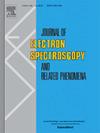Fine structure of spectra for secondary electron excited by electron impact – Novel spectrum data analysis and application to nearly free electron metals
IF 1.5
4区 物理与天体物理
Q2 SPECTROSCOPY
Journal of Electron Spectroscopy and Related Phenomena
Pub Date : 2025-04-12
DOI:10.1016/j.elspec.2025.147539
引用次数: 0
Abstract
In order to analyze the fine structure of the energy distribution of secondary electrons generated through the cascade process, we measured the electron spectra of NFE metals (Li, Mg, Al, Ca, Ga, In), their compounds (Al2O3 and GaAs) and Fe as transition metal with a CMA-type analyzer with absolute gain. We propose that the spectrum obtained by differentiating the energy spectrum in a logarithmic representation (defined as DLS) can be used to evaluate the excitation function that generates the fine structure of the secondary electron energy distribution. We found that the fine structure of the energy distribution of secondary electrons in NFE metals is mainly due to emission through a cascade process generated by the electrons from plasmon decay, which was obtained from analyses of the DLS, the excitation function, the energy distribution of secondary electrons N(E), and the EELS spectra. In addition, slow Auger electrons also generate secondary electrons through the cascade process. In Al2O3, a fine structure of secondary electrons was generated by electrons excited to unoccupied states by inter-band transitions and inner-shell excitation. In GaAs, both contributions from plasmon decay and electrons excited to unoccupied states by inter-band transitions and inner-shell excitation were observed. Based on these findings, it is concluded that the fine structure of the energy distribution of the secondary electrons emitted in the cascade process is due to the following electrons: 1) electrons from plasmon decay, 2) slow Auger electrons, and 3) electrons excited to unoccupied states by inter-band transitions or inner-shell excitation. These fine structures are superimposed on the structure of the individual excitation by primary electrons.
电子碰撞激发二次电子能谱的精细结构——新型能谱数据分析及其在近自由电子金属中的应用
为了分析通过级联过程产生的次级电子能量分布的精细结构,我们使用具有绝对增益的cma型分析仪测量了NFE金属(Li, Mg, Al, Ca, Ga, In)及其化合物(Al2O3和GaAs)和Fe作为过渡金属的电子能谱。我们提出用对数表示(定义为DLS)微分能谱得到的谱可以用来评价产生次级电子能量分布精细结构的激发函数。通过对DLS、激发函数、二次电子能量分布N(E)和EELS谱的分析,我们发现NFE金属中二次电子能量分布的精细结构主要是由等离子体衰变产生的电子通过级联过程发射所致。此外,慢俄歇电子还通过级联过程产生二次电子。在Al2O3中,电子通过带间跃迁和内壳层激发激发到未占据态,产生了精细的二次电子结构。在砷化镓中,观察到等离子体衰变和电子被带间跃迁和内壳层激发激发到未占据态的贡献。基于这些发现,得出了级联过程中发射的次级电子能量分布的精细结构是由以下电子引起的:1)等离子体衰变产生的电子,2)慢俄歇电子,3)带间跃迁或内壳层激发激发到未占据态的电子。这些精细结构叠加在由初级电子激发的单个结构上。
本文章由计算机程序翻译,如有差异,请以英文原文为准。
求助全文
约1分钟内获得全文
求助全文
来源期刊
CiteScore
3.30
自引率
5.30%
发文量
64
审稿时长
60 days
期刊介绍:
The Journal of Electron Spectroscopy and Related Phenomena publishes experimental, theoretical and applied work in the field of electron spectroscopy and electronic structure, involving techniques which use high energy photons (>10 eV) or electrons as probes or detected particles in the investigation.

 求助内容:
求助内容: 应助结果提醒方式:
应助结果提醒方式:


